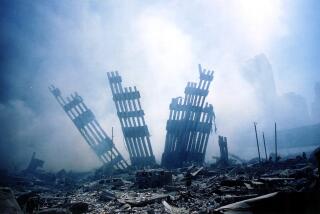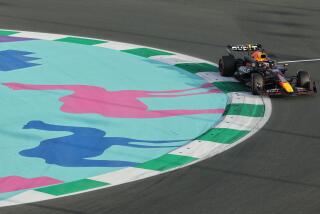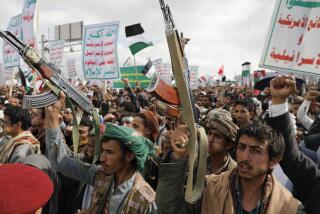Saudi Missiles Remain a Mystery of the Desert
- Share via
AL KHARJ, Saudi Arabia — When the khamsin wind rises and the sand blows, the great Arabian desert can swallow all traces of man. But 7-story-tall missiles? With dozens of Chinese missilemen?
The riddle of Saudi Arabia’s rockets deepens year by year. Where are they? What are they aimed at? What condition are they in? And are Chinese missile crews still out there somewhere in the 300,000-square-mile desert, doggedly doing their duty defending the oil kingdom?
To a resourceful intelligence agency, the missiles aren’t mystifying. Spy satellites have probably spotted them. But the rest of the world is left to wonder. And with good reason.
The Chinese-made CSS-2s are the biggest (70 tons) and longest-range missiles deployed anywhere outside the major nuclear-armed nations. Except for Israel’s, they are probably the only ones with a theoretical nuclear capability.
In a world that closely follows every advance an Iran or Iraq makes in shorter-range missile development, the Saudi weapons with a 2,000-mile reach may also be the least known.
Even Americans who might, don’t.
“I didn’t know about them,” said Brig. Gen. Daniel M. Dick, commander of a new U.S. air base near Al Kharj in central Saudi Arabia, when asked about the missiles. “My pilots are up and flying every day, and we haven’t seen them.”
That’s probably because the launch sites aren’t where Dick’s Air Force patrols fly, to the north, but rather to the south, deeper in the Empty Quarter desert.
Officials in this secretive country aren’t saying. In fact, they’ve said little since 1988, when they tersely confirmed reports that they had bought CSS-2s from the Chinese--to help, they said, in “propagating peace.”
The deal came as Washington dragged its feet on a Saudi request to buy improved F-15 warplanes. The immediate threat the Saudis saw was Iran.
A frustrated Prince Bandar bin Sultan, the Saudi ambassador in Washington, flew to Asia and reportedly handed over $2.5 billion to $3.5 billion to the Chinese for 60 of the aging, relatively inaccurate “East Wind” missiles. Separate contracts supplied Chinese crews to maintain and--apparently--operate them if ever needed.
Some reports said the Saudis got the basic version of the stubby-finned rocket, with a 1,600-mile-plus range. Others said they bought an improved, 2,200-mile model. Either way, the missiles could reach Russia, India, the Balkans and--easily--Israel.
When word of the missiles leaked out in March 1988, Israel immediately hinted at preemptive air strikes to destroy them, and the Americans urged the Saudis to return them to China.
At that point, Prince Bandar recently disclosed, he had a tense midnight meeting with Colin Powell, President Reagan’s national security advisor, and the Israeli-Saudi confrontation was defused. The Saudis disavowed nuclear and chemical warheads, and the missiles, figuratively, dropped from sight.
Nine years later, “they’re still out there,” said a foreign intelligence source who monitors the Saudi military.
First reports suggested that the missiles would be based either at the new military complex in Al Kharj, 80 miles south of Riyadh, or at the older King Khaled Military City, 250 miles north of the capital.
But this source said the missiles would never have been put in “big places like that, where foreigners would be coming and going and see the Chinese.”
He wouldn’t say where they are, although the military-information group Jane’s says that they are deployed at remote As Sulayyil, more than 200 miles south of Al Kharj.
And the source said the Chinese crews apparently are still on duty. “We have not heard that they have left.”
Those familiar with the Saudi military question whether it could, on its own, properly handle the volatile, liquid-fueled missiles.
“These missiles have to be maintained to keep them from rotting,” Israeli missile specialist Gerald M. Steinberg said in Jerusalem. “The ignition assembly is a special problem. A slight flaw and it will blow up.”
An American expert, Aaron Karp, wonders whether the Saudis may soon tire of the expense and trouble.
Since the CSS-2’s accuracy is far from pinpoint--it is estimated that half of those fired would land more than 1,000 yards from their target--and since it has only conventional warheads, the strike force “serves no clear strategic role,” Karp said.
He regards Saudi Arabia as the world’s “most likely candidate” for unilaterally dismantling its own missile fleet.
But apparently not just yet: In a March 11 interview with the U.S. publication Defense News, the Saudi military chief of staff, Lt. Gen. Saleh Mohaya, said the oil kingdom is considering replacing or refurbishing the desert missile force.
More to Read
Sign up for Essential California
The most important California stories and recommendations in your inbox every morning.
You may occasionally receive promotional content from the Los Angeles Times.










